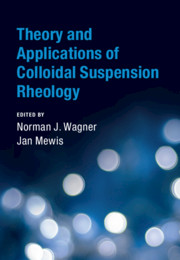Book contents
- Theory and Applications of Colloidal Suspension Rheology
- Cambridge Series in Chemical Engineering
- Theory and Applications of Colloidal Suspension Rheology
- Copyright page
- Dedication
- Contents
- Contributors
- Preface
- General List of Symbols
- Useful Physical Constants and Values
- 1 Introduction to Colloidal Suspension Rheology
- 2 Theory of Colloidal Suspension Structure, Dynamics, and Rheology
- 3 Methods of Colloidal Simulation
- 4 Microstructure under Flow
- 5 Rheology of Colloidal Glasses and Gels
- 6 Suspensions of Soft Colloidal Particles
- 7 Biocolloid Rheology
- 8 Hemorheology
- 9 Applications
- Index
- References
8 - Hemorheology
Published online by Cambridge University Press: 07 April 2021
- Theory and Applications of Colloidal Suspension Rheology
- Cambridge Series in Chemical Engineering
- Theory and Applications of Colloidal Suspension Rheology
- Copyright page
- Dedication
- Contents
- Contributors
- Preface
- General List of Symbols
- Useful Physical Constants and Values
- 1 Introduction to Colloidal Suspension Rheology
- 2 Theory of Colloidal Suspension Structure, Dynamics, and Rheology
- 3 Methods of Colloidal Simulation
- 4 Microstructure under Flow
- 5 Rheology of Colloidal Glasses and Gels
- 6 Suspensions of Soft Colloidal Particles
- 7 Biocolloid Rheology
- 8 Hemorheology
- 9 Applications
- Index
- References
Summary
Blood is a concentrated suspension of deformable, aggregating, red blood cells within a medium of other cells and proteins. It is a complex colloidal system with a non-Newtonian rheology that is characterized by viscoplasticity, thixotropy, and viscoelasticity. After reviewing some of the key biological characteristics of human blood, and after presenting a short historical review of the subject, we present some recent accomplishments. These range from the development of a parameterized Casson model, based on the hematocrit and fibrinogen levels, to the discussion of several recent structural models that are able to capture several of the time-dependent rheological effects of blood. A comparison is also offered between model predictions and the results of recent transient measurements, some involving a newly proposed variant of LAOS: the Unidirectional LAOS. The latter experiment is especially appropriate for the study of blood rheology as it follows roughly the flow experienced by blood in the arterial circulation. It consists of a superposition of steady and large amplitude oscillatory flow in such a way that flow reversal is avoided. Some additional models are discussed along with the challenges and opportunities for future research.
- Type
- Chapter
- Information
- Theory and Applications of Colloidal Suspension Rheology , pp. 316 - 351Publisher: Cambridge University PressPrint publication year: 2021
References
- 3
- Cited by



